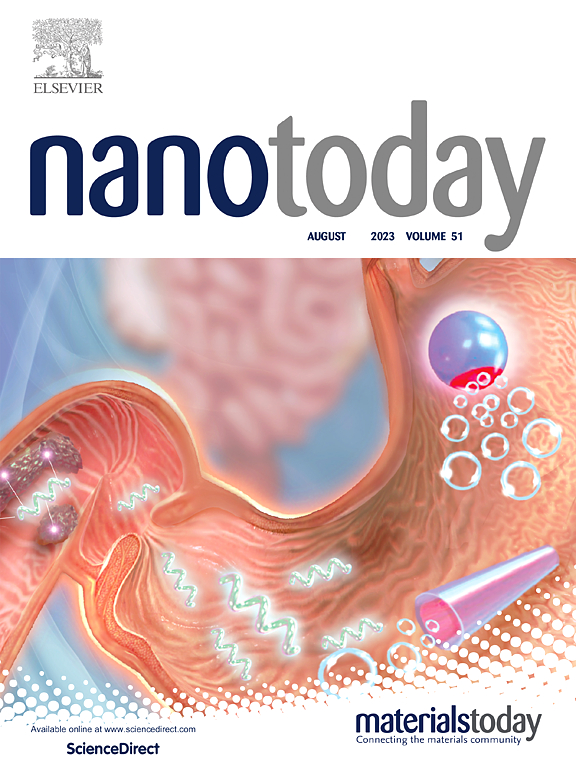Splenic response to protein corona of nanoparticles in vivo
IF 13.2
1区 材料科学
Q1 CHEMISTRY, MULTIDISCIPLINARY
引用次数: 0
Abstract
The spleen is a meeting point between antigens transported by the blood stream and the immune apparatus responsible for mounting the host response. However, the interactions between nanomaterials and the spleen, significantly influenced by the protein corona formed on the surface of nanomaterials, are often overlooked. To address this issue, Fe3O4 nanoparticles with two distinct surface coatings, i.e., diphosphonate-polyethylene glycol (DP-PEG), and diphosphonate-ε-aminocaproic acid (DP-EACA), were selected for a comprehensive investigation into the impacts of protein corona on the immune response within the spleen, attempting to gain a deeper understanding on how protein corona disturbs the immune response in the spleen to enrich the knowledge about the surface chemistry of nanoparticles. Additionally, carboxymethyl dextran (CM-DEX)-modified Fe3O4 nanoparticles, a generic form of the clinically used nanodrug Ferumoxytol, were chosen as a reference. The protein adsorption and its impacts on immune cells, gene expression, and metabolites in the spleen were investigated over a 28-day period. Our findings indicated that the opsonins carried by Fe3O4 nanoparticles were strongly correlated with immune response and metabolic disturbances in the spleen. However, DP-PEG coating exhibited remarkable resistance against protein adsorption and minimized spleen perturbation, highlighting its outstanding potential for clinical applications. All these findings are believed very valuable for developing clinically translatable drugs based on nanomaterials.
脾脏对体内纳米颗粒蛋白冠的反应
脾脏是由血液运输的抗原和负责建立宿主反应的免疫装置之间的交汇点。然而,纳米材料与脾脏之间的相互作用,受到纳米材料表面形成的蛋白质电晕的显著影响,往往被忽视。为了解决这一问题,我们选择了具有两种不同表面涂层的Fe3O4纳米颗粒,即二膦酸-聚乙二醇(DP-PEG)和二膦酸-ε-氨基己酸(DP-EACA),全面研究了蛋白质冠对脾脏免疫反应的影响,试图更深入地了解蛋白质冠如何干扰脾脏免疫反应,以丰富纳米颗粒的表面化学知识。此外,还选择了羧甲基葡聚糖(CM-DEX)修饰的Fe3O4纳米颗粒作为参考,这是临床使用的纳米药物阿魏木糖醇的通用形式。在28天的时间里,研究了蛋白质吸附及其对免疫细胞、基因表达和脾脏代谢物的影响。我们的研究结果表明,Fe3O4纳米颗粒携带的调理素与免疫反应和脾脏代谢紊乱密切相关。然而,DP-PEG涂层表现出显著的抗蛋白质吸附和最小化脾脏扰动,突出了其突出的临床应用潜力。这些发现对于开发基于纳米材料的临床可翻译药物具有重要价值。
本文章由计算机程序翻译,如有差异,请以英文原文为准。
求助全文
约1分钟内获得全文
求助全文
来源期刊

Nano Today
工程技术-材料科学:综合
CiteScore
21.50
自引率
3.40%
发文量
305
审稿时长
40 days
期刊介绍:
Nano Today is a journal dedicated to publishing influential and innovative work in the field of nanoscience and technology. It covers a wide range of subject areas including biomaterials, materials chemistry, materials science, chemistry, bioengineering, biochemistry, genetics and molecular biology, engineering, and nanotechnology. The journal considers articles that inform readers about the latest research, breakthroughs, and topical issues in these fields. It provides comprehensive coverage through a mixture of peer-reviewed articles, research news, and information on key developments. Nano Today is abstracted and indexed in Science Citation Index, Ei Compendex, Embase, Scopus, and INSPEC.
 求助内容:
求助内容: 应助结果提醒方式:
应助结果提醒方式:


